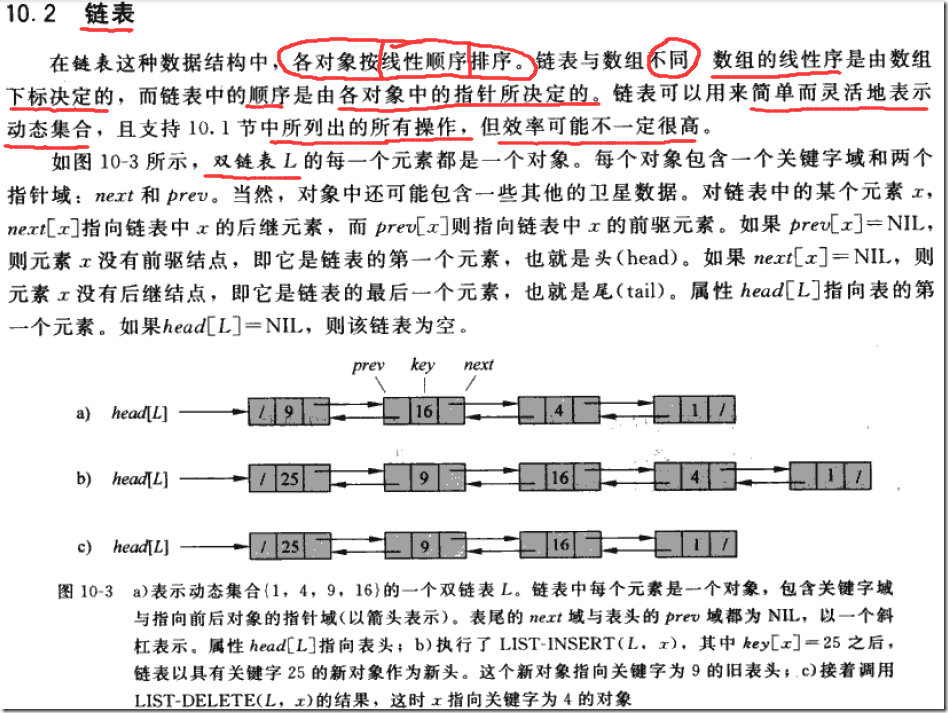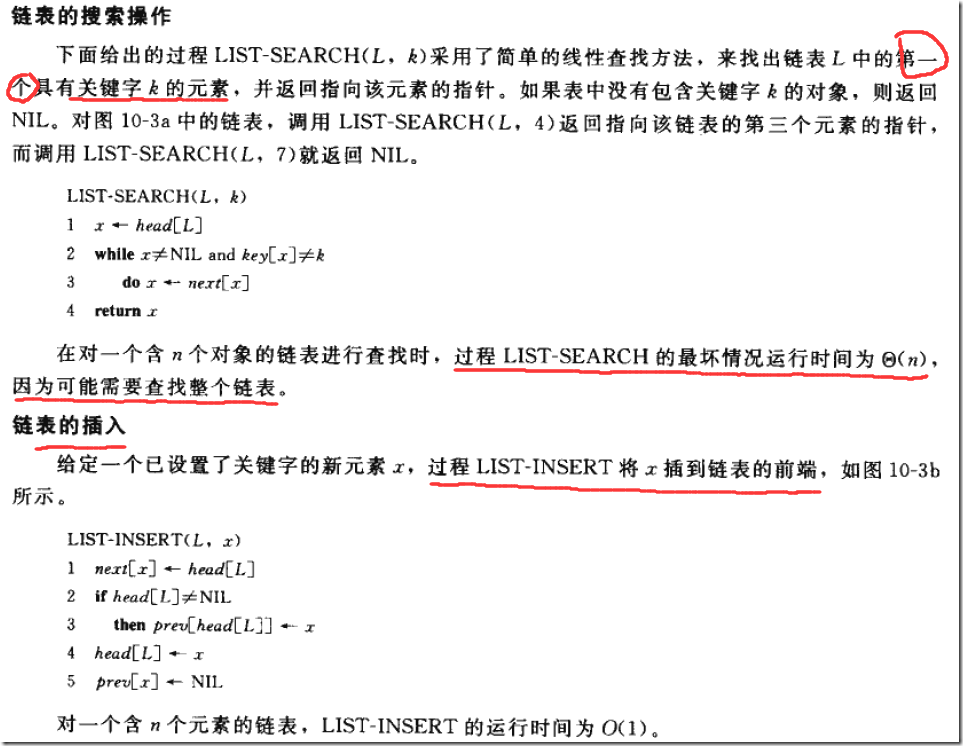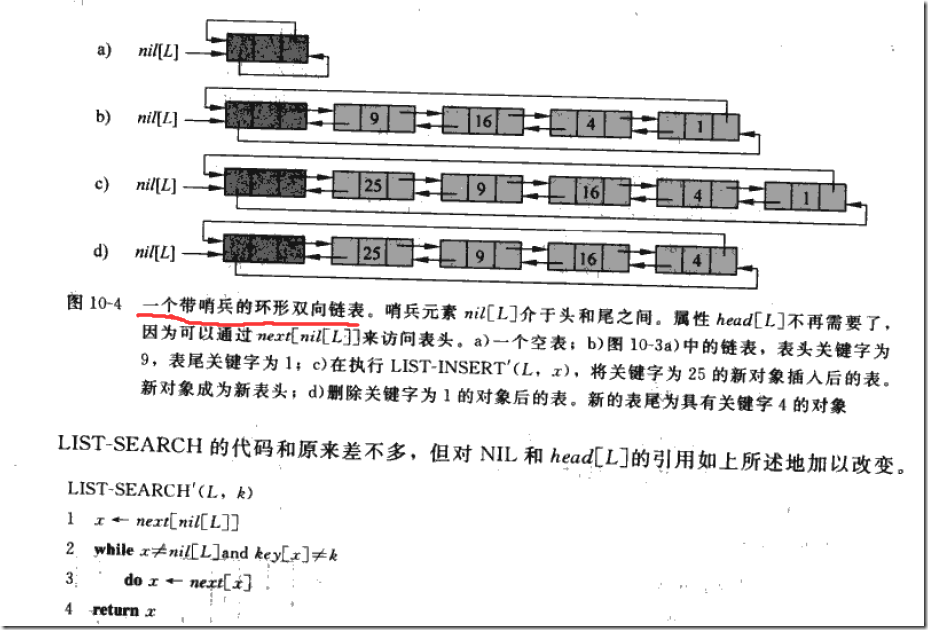算法导论10.2链表
带哨兵的双向链表,代码中我使用了nullptr,所以需要编译器升级,我的编译器是gcc/g++ 4.7.0这是可以的,编译的时候加参数—std=c++0x
节点中还可能有卫星元素
/*
* IA_10.2LinkedLists.h
*
* Created on: Feb 13, 2015
* Author: sunyj
*/
#ifndef IA_10_2LINKEDLISTS_H_
#define IA_10_2LINKEDLISTS_H_
#include <iostream>
// T is void* is a good idea for some application
// key is a variable of type "Type"
// data is a variable of Type "T"
template <class Type, class T> class Node {
public:
/*friend bool operator< <T>(const Node<T>&, const Node<T>&);
friend bool operator== <T>(const Node<T>& lhs, const Node<T>& rhs);*/
Node() : key(0), prev(nullptr), next(nullptr) { }
Node(Type k) : key(k), prev(nullptr), next(nullptr) { }
Node(Type const k, T const d) : key(k), data(d), prev(nullptr), next(nullptr) { }
Type key;
T data;
Node* prev;
Node* next;
};
// LIST-SEARCH(L, k)
// x = L.nil.next
// while ( x != L.nil and x.key != k)
// x = x.next
// return x
// LIST-INSERT(L, x)
// x.next = L.nil.next
// L.nil.next.prev = x
// L.nil.next = x
// x.prev = L.nil
// LIST-DELETE(L, x)
// x.prev.next = x.next
// x.next.prev = x.prev
template <class Type, class T> class LinkedList {
public:
LinkedList() : nil(&m_nil)
{
nil->prev = nil;
nil->next = nil;
}
Node<Type, T>* search(Type const k) // find node by key
{
Node<Type, T>* x = nil->next;
while (x != nil && k != x->key)
{
x = x->next;
}
if (nil == x)
{
return nullptr;
}
return x;
}
// insert the address of the node, at the head of the list
void insert(Node<Type, T>* x)
{
x->next = nil->next;
nil->next->prev = x;
nil->next = x;
x->prev = nil;
}
void del(Node<Type, T>* x)
{
x->prev->next = x->next;
x->next->prev = x->prev;
}
Node<Type, T>* GetNil()
{
return nil;
}
void print()
{
Node<Type, T>* x = nil->next;
while (nil != x)
{
std::cout << x->key << " ";
x = x->next;
}
std::cout << std::endl;
}
private:
Node<Type, T> m_nil; // empty list has one node, pointer nil points to it.
Node<Type, T>* nil;
};
#endif /* IA_10_2LINKEDLISTS_H_ */
/*
* IA_10.2LinkedLists.cpp
*
* Created on: Feb 12, 2015
* Author: sunyj
*/
#include "IA_10.2LinkedLists.h"
int main()
{
// first int64_t means the class type of key is int64_t
// second int64_t means the class type of data stored in node is int64_t
LinkedList<int64_t, int64_t> list;
Node<int64_t, int64_t> node1(1, 100);
Node<int64_t, int64_t> node4(4, 400);
Node<int64_t, int64_t> node16(16, 1600);
Node<int64_t, int64_t> node9(9, 900);
list.insert(&node1);
list.insert(&node4);
list.insert(&node16);
list.insert(&node9);
list.print();
Node<int64_t, int64_t> node25(25, 2500);
list.insert(&node25);
list.print();
list.del(&node1);
list.print();
Node<int64_t, int64_t>* tmp;
tmp = list.search(9);
list.del(tmp);
list.print();
return 0;
}




![J[]UU0XED02CVAER[32MUCG J[]UU0XED02CVAER[32MUCG](http://images0.cnblogs.com/blog/405501/201502/121035456839917.png)
![INCPZKW[]][XRS[{V2K$7)7 INCPZKW[]][XRS[{V2K$7)7](http://images0.cnblogs.com/blog/405501/201502/121035493399800.png)

![$[IX4731Y6SFLCNMVK]4ZMC $[IX4731Y6SFLCNMVK]4ZMC](http://images0.cnblogs.com/blog/405501/201502/121035559338653.png)
![`6HP~9Q0NC44BF}$O2J]`S9 `6HP~9Q0NC44BF}$O2J]`S9](http://images0.cnblogs.com/blog/405501/201502/121035593081322.png)











 浙公网安备 33010602011771号
浙公网安备 33010602011771号